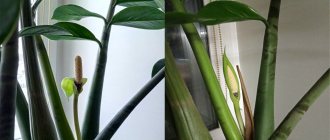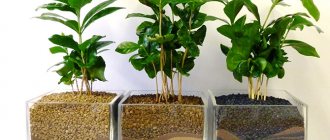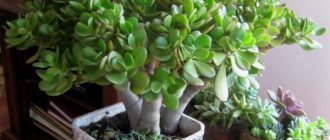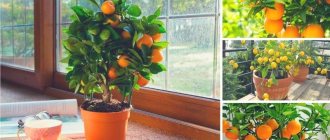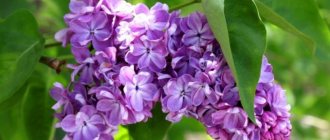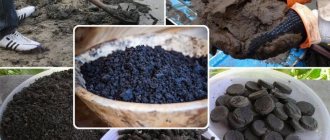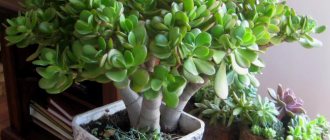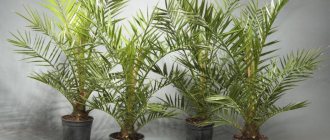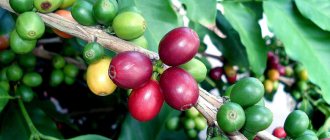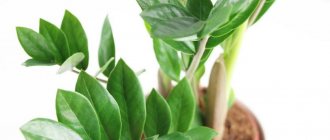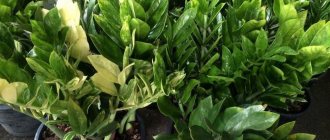Flower growers are happy to grow ardisia indoors. This representative of the Marsin family received another name for its spectacular and bright bunches of berries - coral tree.
In the wild, trees are found everywhere in the tropics and subtropics, differing from each other in height, shape and shade of flowers and berries. But they have one common feature - the fruits stay on the home bush for up to a year, while decorating the room with unusually bright colors.
Home care
There should not be any particular problems in growing ardisia, since it is quite unpretentious. You just need to know what conditions are acceptable for a tropical plant and strictly follow them.
Location and lighting
There should be a lot of light, but it must be diffused. Therefore, it is better not to choose southern windows for a pot, giving preference to western or eastern ones. The scorching rays of the sun in summer can cause burns on the leaves. If you still choose a south window, then shade the bush in the warm season.
Temperature
In summer, moderate heat is preferable - +20-25°C. In winter, the air should be much cooler - within + 14-16°C. It is during this period that the buds are laid. If it gets hotter, they will either fall off, or the flowering will be weak and sparse.
Just don't overdo it with coolness. If the air cools to +7 degrees, this can lead to the death of the pet.
Watering
Ardisia should be watered regularly, especially during flowering and fruiting. Make sure that the earthen ball does not dry out. As soon as the top substrate dries a little, immediately splash some water. But do not overwater, so that the root system does not begin to rot.
In summer, on average, you will have to water every other day or two. In winter, once or twice a week will be enough.
Air humidity
The ideal humidity for a woody tropical plant is 55%. In principle, it is not difficult to achieve. Try to spray the bush more often with settled water at room temperature. This way you will not only increase air humidity, but also prevent the appearance of spider mites.
When ardisia blooms, stop spraying. At this time, it is better to wipe the leaves with a damp and well-wrung cloth. You can start spraying the plant again only after setting the berries. If the room is too dry, the flowers will quickly fall off.
The soil
Neutral soil is suitable for growing. It should be loose, well breathable, and enriched with nutrients. So it is recommended to buy the substrate at a flower shop.
But if you are used to doing everything yourself, prepare the following soil mixture:
- 33% deciduous land;
- 33% river sand;
- 33% peat;
- 1% sphagnum or charcoal.
Feeding and fertilizers
Feed your pet with complex mineral fertilizers once every 15 days. Start doing this in early spring and continue until late autumn. Leave the plant dormant in winter.
Transfer
The ardisia will signal you that the time has come to transplant it into a larger flowerpot with its roots crawling out. In principle, transplantation can be carried out at any time of the year. But it is better to do this at the end of February - beginning of March.
Choose a pot that is not much larger in size than the previous one. If it is too spacious, the coral tree will throw out a weak color. Be sure to line the bottom of the container with a drainage layer of expanded clay, broken brick or small pebbles. Cover it with a layer of substrate.
Remove the bush from the old pot along with the earthen lump. Do this very carefully so as not to damage the roots. Having placed it in a new pot, fill the resulting gaps with prepared soil.
While the plant is young, replant it every year. When it comes into force, the intervals between transfers can be increased.
Trimming
To prevent the flower from stretching upward, but to have a compact, beautiful shape, it should be pinched in the spring (before flowering begins). Then the bush will become more magnificent and will look more aesthetically pleasing. When pruning, mercilessly get rid of damaged, weak and too old shoots.
Planting in the ground, transplanting
Having purchased a houseplant ardisia, you should not rush to plant it in a beautiful pot. Ardisia will need adaptation. To do this, it is necessary to quarantine the plant for at least two weeks, i.e. away from other indoor plants. In this case, it is necessary to maintain a comfortable air temperature (it should not be too hot), avoid drafts and provide moderate watering.
If the plant begins to lose its lower leaves, you should increase watering slightly. But there is no need to worry, this is quite normal for the adaptation period. If no other signs of “ill health” of the ardisia are found during the quarantine period, it can be safely replanted.
Ardisia transplantation is carried out using the transshipment method. This must be done carefully so as not to harm the root system. Since ardisia feeds from the soil only through symbiosis of its roots with soil fungi. You cannot wash the roots off the ground during transplantation. The root system must be taken from the ground and placed in a new pot.
Ardisia does not have any special requirements for the soil. The most common universal primer will do. You can take soil that is either slightly alkaline or slightly acidic. But if we talk about creating ideal conditions for tropical ardisia, then the best combination would be a mixture of equal parts of leaf soil, peat and sand. You can also add some crushed charcoal or coconut fiber.
The bottom of the pot must be covered with a drainage layer. It will protect the roots of the plant from excess moisture and rotting.
As for further replanting, a young plant (up to 4 years old) needs to be replanted once a year in early March. It is better not to disturb mature plants unnecessarily. It is enough to loosen the top layer of soil or replace it with a new one.
An adult ardisia should be replanted only when its pot has become small. However, you should not choose a pot for replanting that is too large. This can lead to slower growth of ardisia and its poor flowering.
Bloom
Ardisia blooms with small flowers. They can be white, pink or red. The flowers are collected in umbrellas or panicles.
The flowering process begins in late spring or early summer. Protect your ward from drafts so that the buds do not fall off. During this period, water more often than usual. In autumn, until December, small fruits ripen. They can stay on the plant for up to a year. The berries are not poisonous, but it is better not to eat them.
Brief instructions for the care and maintenance of ardisia
| Air temperature | From +19°C to +25°C, in the cold season from +14°C to +16°C |
| Air humidity | Above average, 50-60% |
| Watering | Abundant, when the air temperature drops, watering is reduced |
| Transfer | Plants under 3 years old - once a year, plants older than 3 years - as they grow |
| Priming | Universal, but the ideal option would be a mixture of garden soil, peat, sand and charcoal |
| Lighting | Bright, but not exposed to direct sunlight |
| Reproduction | Seeds and cuttings |
Reproduction
Guests from the tropics can be propagated in two ways: using cuttings or seeds. At the same time, cutting cuttings is very troublesome, so only experienced gardeners can do it. For amateurs and beginning flower lovers, it is better to sow seeds. This should be done in spring or summer.
Cuttings
When pruning, the tops of the shoots do not need to be thrown away, but rather planted in small containers. Before sending for rooting, treat with a root-forming agent, for example, kornevin. The substrate in the pot should be heated to +26 degrees. The sprouts should be kept in diffused light. The air should be heated to +25 degrees.
When the seedlings take root, plant them in a permanent place. It will take a long time for the roots to appear, so be patient.
Seeds
It is much easier to get new ardisias from seeds. In January, select berries on the bush with a volume of at least 1 cm. Separate the pulp, saw off the seeds and soak in a solution that stimulates growth, and then place them in a damp soil mixture. Planting depth is about one centimeter. Set up a mini-greenhouse by covering the container on top with glass or stretching film. Place in a warm place. After about 40 days, the first shoots should appear.
Wait until they get stronger and plant them in separate pots, filling them with soil mixture. You will have to wait 2-3 years for the moment of flowering.
The seeds do not last long, so plant them as soon as possible, without waiting for spring.
Diseases and pests
Most often, ardisia suffers from chlorosis. This fungus “paints” a light mesh on the leaves. It develops from a lack of iron in the soil. So, in order to prevent the disease, apply fertilizers that contain iron preparations more often.
Cherevtsy may attack. In this case, the soil should be replaced with new one and the bush should be treated with an insecticide.
Among the pests seen on evergreen plants are also:
- scale insect;
- aphid;
- spider mite
All of them can be gotten rid of with the help of insecticidal preparations. It is imperative to combat pests, as they not only spoil the appearance of the bush, but can cause its death.
Care errors
Those who ignore proper care of ardisia will have to face various problems.
- Dry brown spots on leaves. Appear due to sunburn. Shade the plant with white paper or tulle. This may also be a consequence of too high air humidity or stagnant moisture in the root system.
- The leaves began to turn yellow. The bush lacks nutrients, especially nitrogen, and the air humidity is too low. Spray the foliage and fertilize.
- The leaves have turned brown at the edges. Problems with watering: it is excessive or, on the contrary, insufficient. Please resolve this issue.
- The leaves have become soft and curled. Too large temperature fluctuations during the day or a cold draft caused trouble. Address these shortcomings.
- Faded leaves and elongated stems. The pet is experiencing a lack of light. In winter, daylight hours should be increased by artificial lighting. If this happens in the summer, take the pot outside, placing it in a quiet, windless place.
- Soft and saggy foliage. Talks about the need to urgently water.
Ardisia care, care and maintenance
The main advantage of the indoor plant Ardisia is its ease of care and not being picky.
Ardisia is a light-loving plant. Any windows except southern and northern ones are suitable for placing this tropical beauty. South windows should be shaded, as direct sunlight is dangerous for the plant. On the north windows, on the contrary, additional lighting may be required. It will also be very useful in winter, when daylight hours are much shorter.
Comfortable air temperature for ardisia in the spring and summer months is from +19°C to +25°C. It is better to avoid too high temperatures, otherwise the main decoration of ardisia - its berries - may dry out and crumble. In the autumn-winter months, the plant should be moved to a cooler place with an air temperature of +14°C to +16°C. It is during the winter period that ardisia buds form, and if the plant is left warm, its flowering will be modest.
Folk signs
Attentive people find a lot in common in the appearance of clusters of ardisia and rowan berries. Therefore, the Japanese rowan is also considered a widow's tree. They say that wives often plant colorful flowers on the graves of husbands who have died prematurely.
But there are also good signs.
It has long been believed that a necklace made of coral berries will protect you from all sorts of troubles. It will give courage to warriors, and beauty to young maidens.
Having placed the pot on the window of your house, rest assured: the plant will protect you from an unkind eye and an evil word. And an atmosphere of warmth, peace and mutual understanding will reign in the family.
Medicinal properties
The Chinese successfully use extracts obtained from fruits, roots and leaves to treat infectious diseases of the respiratory system. They are used for injuries and rheumatoid arthritis. The berries are believed to help with snake bites.
Just don’t even think about decorating your children’s room with this flower. When a child sees large red berries, he will definitely want to eat them, which can lead to allergies.
What is she like?
Like most flowerpots that are fashionable today, ardisia was brought from the tropics of America. It is also common in the forests of Asia and Australia.
The name of the genus is translated from Greek as “arrow” - indeed, the flowers of the plant resemble miniature arrows.
They appear in mid-December (although, depending on the variety, they can bloom in other seasons - late spring, mid-summer). Most often their small petals are white, sometimes pink.
Very quickly they are replaced by berries, for which, in fact, the tree is grown. They may be white or pinkish at first, but then become scarlet (less often black - it depends on the type of ardisia).
The berries ripen over several months, leaving behind one seed at a time.
The leaves also look interesting. They have a glossy boat shape with slightly wavy edges. You can often feel swellings along the edges of the leaf blade. Don’t be afraid, this is not a disease - here (and also in the roots) the plant has special bacteria that help the flower absorb nitrogen directly from the air. Without them, ardisia will dry out.
In the wild, ardisia can be a tree, shrub or subshrub. Most often it grows up to 2 meters, although other species reach up to eight. In our houses it is a miniature potted tree with one trunk. All year round it is considered a decorative leaf, and on New Year’s Eve it is decorated with berries.
Types of flowers that we sell
There are up to 800 species in this genus. True, only a few were “tamed”, and even fewer ended up in our stores.
Ardisia crenate (crenata). The most popular type. In most photos it is a small pot, but if you grow crenata for a long time, it will grow to the ceiling. Its flowers are white or cream and smell pleasant. Depending on the variety, the berries can last from several months to a whole year. There are varieties not only with scarlet, but also with cream or white berries.
Curly. So named because of the wavy edges of the leaves. This is a more compact species - it grows not up to 2 meters, like crenata, but up to 80 cm. It blooms white and pink, and in the summer. Its red berries can hang on the branches all year round.
Low. It is really squat - the tree grows only up to 25 cm (despite the fact that some leaves stretch up to 15 cm). The berries are pinkish at first and then turn black.
Japanese. Another low (30-40 cm) species. The bush has rounded leaves, cream flowers, red berries at first and dark ones when ripe. The Chinese grow this plant as a medicinal plant - they believe that the flower secretes a substance that can fight cancer. Also in the Middle Kingdom, decoctions are made from the roots and leaves of ardisia (various types) to treat colds and infections.
Kinds
There are up to eight hundred varieties of Ardisia. The most common are the following.
Gorodchataya
Flower growers grow this species most often. A powerful plant can stretch up to 2 m. Although it does not grow too fast. Beautiful clusters of fruits stay on the bush for up to a year. The leaves are also impressive with their wavy edges. The flowers are predominantly pink, but sometimes white.
Curly
Usually this bush does not grow higher than 80 cm. Small cream flowers gather in panicles and bloom very luxuriantly. Despite the fact that there are still ripe coral berries on the neighboring stems. The leaves have a wavy edge and are shiny.
Low
The most compact species with 15 cm dark green leaves and light pink drooping flowers. The berries are initially red-brown in color, but as they ripen they turn black and shine beautifully.
Solanacea
The leaves are pale green and the shoots are light red in color. They are not as wide as those of previous comrades. Purple or pink small flowers cannot charm anyone. But when the berries appear, they are initially pale red in color, and over time they darken and become shiny.
Elliptical
A bush with pinkish flowers and red berries ripening in their place. Over time they turn purple.
Ardisia crenate (Ardisia crenata) and its photo
The most common species is Ardisia crenata. It can grow up to two meters, and its bright red fruits can remain on the plant for even more than one year. The leaves have a dark green tint, which attracts our attention. Ardisia crenate grows in subtropical forests of China, Korea, the islands of Japan and India almost everywhere.
The Ardisia crenate plant is a small plant up to one meter high, with branches arranged in tiers.
This species has a very dense crown of leaves. It is also decorated with wreaths of berries, which are located at the base. If the plant is placed in a pot where it is a little cramped, then, oddly enough, it will produce color and fruit much better. Look at the photo of Ardisia crenate:
In spring or summer, small and not very clearly defined, but fragrant, white flowers with a hint of pink appear.
A short period of time after the flowers appear on Ardisia crenate, rounded drupes begin to be visible. Initially they have a light orange tint, and by autumn they become light red.
To date, varieties with white and pink berries have also been bred.
In botanical science, this species is called “Ardisia crenata”.
After flowering, if the plant has been well cared for, you can see berries up to 1 cm in diameter. At first they have a greenish tint, then turn red and become coral red. They resemble rowan berries in their appearance and structure. Due to this, it is also called “coral tree”. Before Christmas, the berries are most pronounced and diverse.
Ardisia crenata is one of a fairly small number of plants that bear fruit at home. The flower propagates both by cuttings and by seeds, which can appear in fruits that have not fallen from the plant. The plant reproduces better by seeds. The first shoots appear after about a month.
How to choose ardisia
When going to the store for this coral miracle, be sure to make sure that they offer you a quality copy:
- If the roots are visible, they should be clean, without rotten rot or any damage.
- Make sure there are no bugs or larvae in the substrate.
- The leaves should not be dry, damaged, yellow or limp.
- In addition to blooming flowers, look for buds. During a move, a plant may drop its flowers due to stress, and the buds will bloom after some time.
Happy shopping!
Be sure to make room in your green corner for this plant with wonderful berries. Ardisia will become a year-round decoration for your home. And in winter, contemplating its bright berries, you can avoid depression.
